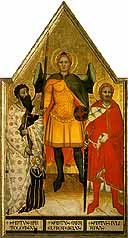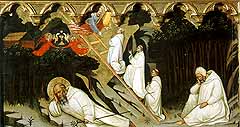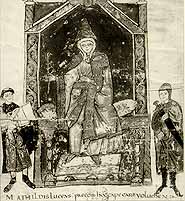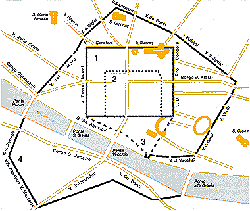
Roman "Florentia"
The period of greatest commercial and agricultural prosperity for Roman Florence ("Florentia", city-flower), founded in around 59 B.C., was during the reign of the Emperor Hadrian (117-138 d.C.), when an amphitheatre to seat 20.000 was built (124-130 A.D.), and again in around 285 A.D., when it became the seat of a "corrector", who governed an area that reached as far as Umbria and northern Lazio. The preaching of the Gospel had already begun to spread among the rural population living in the outskirts of Florence during the first of these periods: the new religion came from the south, from Rome, and was first brought here by a colony of merchant converts of Syrian origin who settled in Oltrarno (the area south of the river Arno), outside the walls. The primitive Christian community lived where the Cassia road met the Arno, in the area around the Church of Santa Felicitý: the first known forms of Christian worship known evolved around Felicitas, the Palestinian martyr, and Laurence the deacon.

Fra Angelico, St.Laurence
More than a century was to go by before the city was to have its first
martyr, St. Miniato, whose name was clearly of oriental origin. Miniato
(or Minias), perhaps an Armenian prince, was beheaded during the persecutions
of Emperor Decius (249-251 A.D.) and it is said that, after his martyrdom,
he picked up his head, put it under his arm and climbed up to the hill where
he wished to be buried. The basilica of San Miniato was
later built over his tomb.

The altar with the remains
of St.Miniato
313 A.D., the year of Constantine's Edict legalizing the worship of Christ throughout the Empire, was to be another important date in the history of the Christian conversion of Florence. Documents of the time show that the city became a bishopric that year, under the rule of Bishop Felice. 393 was to mark the visit of St. Ambrose, the Archbishop of Milan to the city, when he consacrated the church of San Lorenzo (the first cathedral?) and nominated St. Zanobus as the new Bishop of Florence. The Greek origins of the name Zanobus are yet another demonstration that the ex-Roman colony's conversion to Christianity came about through merchants travelling from the Orient.

Mosaic with St.Zanobus
The new cathedral was founded thanks to the encouragement of St. Zanobus,
who died in 429; it took its name from St. Maria Reparata, a Palestinian
virgin and martyr (another saint from the Middle East), who, like Miniato,
was killed in the 3rd century during the persecution of Decius. The Saint
is said to have appeared on October 8th 405, the anniversary of her martyrdom,
on the hill behind Fiesole where the Imperial general Stilicho was fighting
off the pagan Goth invaders led by Radagaisus. This gave rise to the desire
to dedicate the city's bishopric to her.

Arnolfo di Cambio,
S.Reparata
The information on Florence of late antiquity was followed by three centuries of silence. all we know is that the city, by then reduced to only 5.000 inhabitants, was conquered and governed in succession by the Goths, Byzantines (6th century), Longobards and Franks. The Byzantines constructed the second ring of city walls, which was even smaller than that built by the Romans. The Longobards founded several churches which were all called after their favourite saints, like the Archangel Michael (today's Orsanmichele is a 14th century evolution of an old Longobard oratory), and St. John the Baptist, their patron saint and Florence's from the time of Theodolinda. Whereas the Franks, after defeating the Longobards in 774, imported the worship of St. Remigius, dedicating a church to him that can still be seen in the square of the same name. According to legend, Charlemagne himself, who is thought to have stayed in Florence in 781 and 786, was directly responsible for the foundation of the church of SS.Apostoli.

School of Giotto,
St. Michael the Archangel
The city was not to recover until the 9th century: in 825, during the reign of Emperor Lothario I, Florence was apparently one of the eight cities in Italy with ecclesiatical schools for the formation of the clergy. The territories of Florence and Fiesole were united in 854 and were the only "comitatus" in the peninsula to have two bishoprics. The area later suffered incursions from the Hungarians as well as raids by the Saracens and Normans, who arrived by sea and sailed up the Arno. The third ring of city walls, the so-called "Carolingian" walls, were built in this period for further defence. Peace returned under the Germanic Imperial dynasty of Otto and the rule of Hugo, the "Grand Baron" of Tuscany, and his mother Willa, who founded the Badia Fiorentina in 978 (where Hugo was buried in 1001). St. Romuald, who founded the monastery of Camaldoli, also lived in this period. Hugo was so fond of "Fiorenza" that it soon replaced Lucca as the centre of the margravate, though it grew even more in importance during the government of the Canossa family: Bonifacio, his wife Beatrice, his daughter Matilde (who died in 1115).

Florentine school,The Dream of St.Romuald
Under the warlike Canossa family, the city became the centre of the religious
reform preached by the monk Ildebrando di Soana (later Pope Gregory VII)
and was extolled as a "new Bethlehem" by St. Pier Damiani. The
following elements give us some idea of its importance: it hosted a Council
for the reform of the Church in 1055, Pope Stephen IX was consacrated here
in 1057 (and later buried in Santa Reparata), while Gherardo, the Bishop
of Florence, was elected Pope Nicholas II in 1059. The city was also to
hear the first sermons preached by St. Giovanni Gualberto, the founder of
the Vallombrosian order and ferocious accuser of the corrupt way of life
of the clergy until his death on July 2nd 1073.

A miniature of Matilde of Canossa
During this period of redevelopment, Matilde di Canossa built the fourth ring of walls (those Dante mentioned as the "old ring of walls"), and, in 1075, granted the city the dignity of a Free Commune, creating the basis for the historical Florentine Republic.

